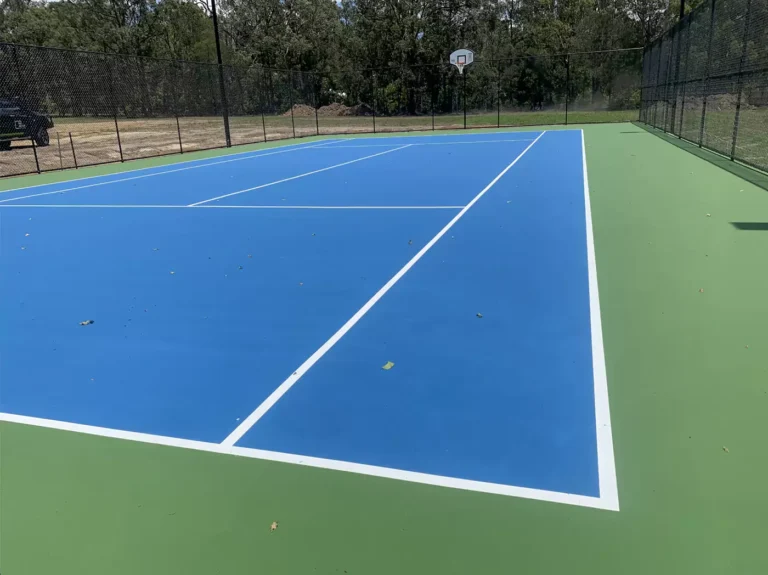Developing a Pickleball Court Construction-- Expert Construction for Top Quality Play
Developing a Pickleball Court Construction-- Expert Construction for Top Quality Play
Blog Article
Sustainable Practices in Pickleball Court Building And Construction You Need To Know
As the popularity of pickleball continues to increase, so as well does the requirement for lasting practices in court construction. This approach not just addresses ecological problems yet also boosts the longevity and functionality of the courts. From picking environmentally friendly products to implementing efficient drainage and energy-saving lighting remedies, there are countless approaches to take into consideration. Yet, the impact of these practices expands far beyond the court itself. Comprehending how each component adds to a much more lasting future welcomes further exploration right into the elaborate equilibrium in between recreational development and environmental stewardship.
Selecting Eco-Friendly Products
Choosing environment-friendly products is a vital action in the building of lasting pickleball courts. The option of sustainable materials not only decreases ecological impact however additionally enhances the longevity and performance of the court. Secret products include recycled rubber for the surface, which provides exceptional resilience and shock absorption while diverting waste from garbage dumps.
Additionally, using in your area sourced products reduces transportation exhausts and sustains local economic situations. Pickleball court construction. Using indigenous woods for fence and seating can offer a sustainable visual while making certain strength against the elements.
Including permeable materials for court structures can additionally add to sustainability by permitting for all-natural water drainage and lowering drainage. These options not just secure local ecosystems yet also advertise healthier play settings.
Efficient Water Drainage Solutions
While the option of green materials is important, applying efficient drain services is just as crucial for keeping lasting pickleball courts. Appropriate water drainage not only shields the court surface from water damage however also minimizes disintegration and runoff, promoting environmental honesty.
Effective drain systems can consist of absorptive paving, which allows water to infiltrate the ground instead of merging externally. This minimizes the chance of standing water, which can lead to mold and other maintenance issues. Furthermore, integrating tactically put drainage channels and swales can direct excess water away from the court location, making sure a completely dry playing surface and preventing soil disintegration.
Making use of native plant life in the landscape design around the courts can better improve drain by absorbing excess water and lowering drainage. These plants require less watering and promote biodiversity, straightening with lasting practices.
Moreover, it is critical to consistently preserve the water drainage system to ensure its long-term efficiency. This includes clearing up debris and surveillance for blockages. By focusing on efficient water drainage services, pickleball court erectors can considerably add to the sustainability and longevity of the facility, inevitably profiting both players and the setting.
Energy-Efficient Lighting Options
As the demand for pickleball proceeds to expand, integrating energy-efficient illumination alternatives right into court design has come to be increasingly crucial for sustainability. Typical lighting systems typically eat excessive energy, contributing to higher operational prices and environmental effect. Adopting modern, energy-efficient technologies is vital for both brand-new building and constructions and remodellings.
LED (Light Emitting Diode) illumination stands apart as a leading option because of its durability and energy savings (Pickleball court construction). Compared to standard lights, LEDs make use of about 75% much less energy and can last approximately 25 visit their website times much longer, substantially minimizing maintenance prices. The directional nature of LED lighting decreases light contamination, ensuring that illumination is concentrated on the court instead than bordering locations.

Sustainable Surface Area Alternatives
Exploring sustainable surface area choices for pickleball courts has actually acquired traction amongst gamers and builders alike. The emphasis on green products not only lines up with the expanding environmental understanding but additionally enhances the efficiency and sturdiness of the courts.
One prominent alternative is making use of recycled rubber, which can be sourced from used tires. This product offers superb shock absorption, minimizing the threat of injuries for gamers while promoting sustainability. Additionally, modular tiles made from recycled plastics use one more practical alternative. These tiles are simple to replace and mount, and their flexibility enables for different court setups.
All-natural grass courts are likewise becoming a sustainable option, advertising biodiversity and decreasing the warmth island result. Nevertheless, they call for normal maintenance and water, which may not line up with all sustainability objectives.

Water Preservation Methods

Another reliable method involves the installment of rainwater harvesting systems. These systems collect and save rainwater for usage in keeping court surfaces and landscape design. This method not just saves safe and clean water however additionally decreases dependence on local resources.
Additionally, using drought-resistant landscaping around the courts is important. Native plants call for much less water and are better adjusted to neighborhood climate conditions, hence lowering overall water intake. In addition, utilizing effective watering systems, such as drip watering, ensures that water is provided directly to plant origins, reducing dissipation and waste.
Verdict
Integrating lasting methods in pickleball court construction substantially adds to ecological preservation and source effectiveness. By focusing on these practices, the building of pickleball courts can line up with broader ecological objectives while advertising durability and capability within neighborhoods.
As the appeal of pickleball proceeds to climb, so too does the requirement for lasting techniques in court construction.Selecting environmentally friendly products is an important action in the building and construction of lasting pickleball courts. By focusing on energy-efficient lights options, pickleball court fabricators can contribute to an extra lasting future while fulfilling the demands of gamers and stakeholders alike.Including lasting surface area options not only boosts the efficiency of pickleball courts however likewise paves the way for implementing effective water preservation strategies.Including sustainable methods in pickleball court construction considerably adds to ecological preservation and resource performance.
Report this page